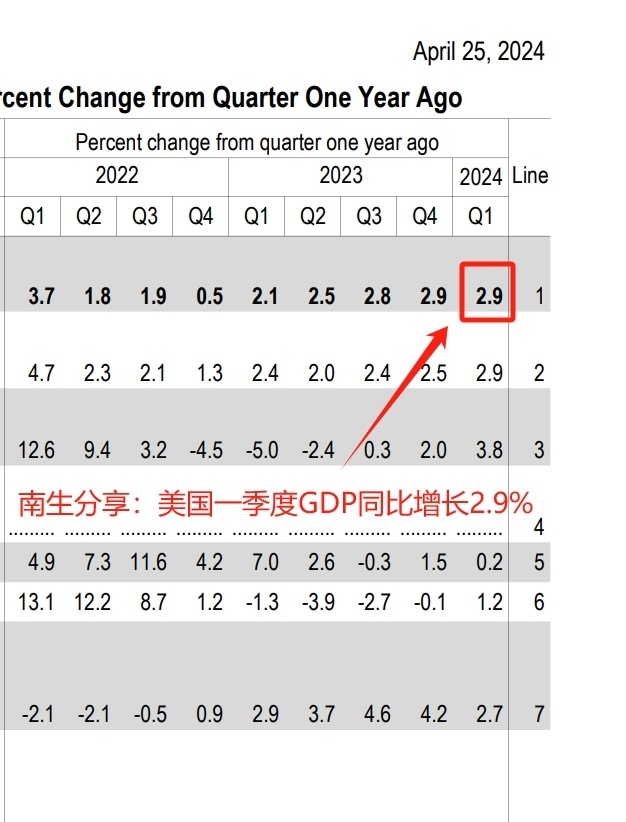The GDP of the United States in the first quarter increased by 2.9% year-on-year, and the growth rate after the new standard is 3%
Nansheng said in this life
2024-04-25 21:35Posted in Guangdong financial field creators
According to the U.S. Department of Commerce, the economy grew at an annualized rate of 1.6% in the first quarter of 2024, lower than market expectations. However, the year-on-year growth rate was as high as 2.9%, exceeding market expectations, mainly due to the growth of healthcare, financial and insurance services.

Without private consumption, the U.S. economy would decline
In previous articles, Nansheng mentioned many times that the core of the U.S. economy is consumption, and the core of consumption is private consumption. Without consumption, the U.S. economy collapses, and that's when there is a major problem – for example, the coronavirus pandemic, the U.S. government issues more money and more Treasury bonds.
The most direct reason for sending money directly to residents to stimulate economic recovery and even bring GDP to a new high. This was once again evident in the course of the US economic development in the first quarter of this year. Let's take the 1.6% month-on-month annualized growth rate as an example, where:
The U.S. import and export balance, that is, foreign trade in goods and services, continued to maintain a deficit by a higher amount than the same period last year, pulling down the GDP in the first quarter of this year by 0.86 percentage points, and continued to be the biggest drag on the continued development of the U.S. economy.
In the first quarter of this year, the "incentive effect of government consumption and investment contributed 0.21 percentage points to GDP development" brought about by the fiscal expenditure of governments at all levels in the United States, and private investment contributed 0.56 percentage points to the economic growth of the United States in the first quarter.
Let's add up the contribution rate of the above three major sectors, which together contributed "minus 0.09 percentage points" to the GDP development of the United States in the first quarter. Private consumption actually contributed 1.68 percentage points to the economic development of the United States in the first quarter, after offsetting the "minus 0.09%" of the previous three.
The U.S. economy grew by 1.59% on an annualized basis in the first quarter, rounded up to 1.6%. In other words, without private consumption, the U.S. economy is not growing, but declining. This is the foundation of prosperity for the United States today, but it is also a hidden danger for the future.
Advance consumption, overdraft consumption, and would rather borrow money to promote residents' consumption. On the premise that US hegemony can be maintained, global capital is focused on the United States, which can continue to supply blood to the US economic development. But the source of blood is limited, and if no one buys US bonds in the future, the bubble will burst.
Many people say that the United States seems to be stunned! Investment, foreign trade, and consumption, for countries including China and Vietnam, it is the troika that promotes economic development, but the United States only likes the single wheel of "consumption." It runs fast, but it may fall.
The U.S. economy could fall, this is the common prediction given by many economic analysts. But before the official fall, it was still showing prosperity, with its economy reaching $27.36 trillion in 2023 and $6,926.1 billion in the first quarter of this year.
The U.S. also publishes a seasonally adjusted GDP
It is worth mentioning that the first-quarter GDP of the United States mentioned above is "calculated without calendar and seasonal adjustment rules". In addition to this accounting standard, the U.S. Department of Commerce also released seasonally adjusted figures of $7,071.1 billion in the first quarter.
Using this criterion, the year-on-year GDP growth rate in the United States in the first quarter was 3%. Since the year-on-year economic growth rate announced by the mainland is "not subject to calendar and seasonal adjustment rules", based on the principle of being as consistent as possible, Nansheng recommends that everyone give priority to 2.9% to report.
Whether it is 2.9% or 3.0%, the economic growth rate of the United States in the first quarter is far lower than the mainland's 5.3%, which is the real level of development after excluding the factor of price changes. However, the price of goods and services in the United States has risen more than in China, combined with the depreciation of the renminbi.
As a result, China's GDP grew by only a modest 0.2% in US dollar terms, while the US GDP grew by about 3% in real terms and contributed about 3% to inflation. What do netizens think about this? This article is written by Nansheng, welcome to forward, comment, leave a message and share!
View original image 165K
-

The GDP of the United States in the first quarter increased by 2.9% year-on-year, and the growth rate after the new standard is 3% -
The GDP of the United States in the first quarter increased by 2.9% year-on-year, and the growth rate after the new standard is 3% -
The GDP of the United States in the first quarter increased by 2.9% year-on-year, and the growth rate after the new standard is 3% -
The GDP of the United States in the first quarter increased by 2.9% year-on-year, and the growth rate after the new standard is 3%
Personal opinion, for reference only